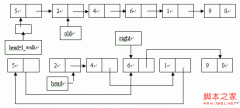C++实现一维向量旋转算法
在《编程珠玑》一书的第二章提到了n元一维向量旋转算法(又称数组循环移位算法)的五种思路,并且比较了它们在时间和空间性能上的区别和优劣。本文将就这一算法做较为深入的分析。具体如下所示:
一、问题描述
将一个n元一维向量向左旋转i个位置。例如,假设n=8,i=3,向量abcdefgh旋转为向量defghabc。简单的代码使用一个n元的中间向量在n步内可完成该工作。你能否仅使用几十个额外字节的内存空间,在正比于n的时间内完成向量的旋转?
二、解决方案
思路一:将向量x中的前i个元素复制到一个临时数组中,接着将余下的n-i个元素左移i个位置,然后再将前i个元素从临时数组中复制到x中余下的位置。
性能:这种方法使用了i个额外的位置,如果i很大则产生了过大的存储空间的消耗。
C++代码实现如下:
/*************************************************************************
> File Name: vector_rotate.cpp
> Author: SongLee
************************************************************************/
#include<iostream>
#include<string>
using namespace std;
int main()
{
string s = "abcdefghijklmn";
cout << "The origin is: " << s << endl;
// 左移个数
int i;
cin >> i;
if(i > s.size())
{
i = i%s.size();
}
// 将前i个元素临时保存
string tmp(s, 0, i);
// 将剩余的左移i个位置
for(int j=i; j<s.size(); ++j)
{
s[j-i] = s[j];
}
s = s.substr(0, s.size()-i) + tmp;
cout << "The result is: "<< s << endl;
return 0;
}
思路二:定义一个函数将x向左旋转一个位置(其时间正比于n),然后调用该函数i次。
性能:这种方法虽然空间复杂度为O(1),但产生了过多的运行时间消耗。
C++代码实现如下:
/*************************************************************************
> File Name: vector_rotate_1.cpp
> Author: SongLee
************************************************************************/
#include<iostream>
#include<string>
using namespace std;
void rotateOnce(string &s)
{
char tmp = s[0];
int i;
for(i=1; i<s.size(); ++i)
{
s[i-1] = s[i];
}
s[i-1] = tmp;
}
int main()
{
string s = "abcdefghijklmn";
cout << "The origin is: " << s << endl;
// 左移个数
int i;
cin >> i;
if(i > s.size())
{
i = i%s.size();
}
// 调用函数i次
while(i--)
{
rotateOnce(s);
}
cout << "The result is: "<< s << endl;
return 0;
}
思路三:移动x[0]到临时变量t中,然后移动x[i]到x[0]中,x[2i]到x[i],依次类推,直到我们又回到x[0]的位置提取元素,此时改为从临时变量t中提取元素,然后结束该过程(当下标大于n时对n取模或者减去n)。如果该过程没有移动全部的元素,就从x[1]开始再次进行移动,总共移动i和n的最大公约数次。
性能:这种方法非常精巧,像书中所说的一样堪称巧妙的杂技表演。空间复杂度为O(1),时间复杂度为线性时间,满足问题的性能要求,但还不是最佳。
C++代码实现如下:
/*************************************************************************
> File Name: vector_rotate_2.cpp
> Author: SongLee
************************************************************************/
#include<iostream>
#include<string>
using namespace std;
// 欧几里德(辗转相除)算法求最大公约数
int gcd(int i, int j)
{
while(1)
{
if(i > j)
{
i = i%j;
if(i == 0)
{
return j;
}
}
if(j > i)
{
j = j%i;
if(j == 0)
{
return i;
}
}
}
}
int main()
{
string s = "abcdefghijklmn";
cout << "The origin is: "<< s << endl;
// 左移个数
int i;
cin >> i;
if(i > s.size())
{
i = i%s.size();
}
// 移动
char tmp;
int times = gcd(s.size(), i);
for(int j=0; j<times; ++j)
{
tmp = s[j];
int pre = j; // 记录上一次的位置
while(1)
{
int t = pre+i;
if(t >= s.size())
t = t-s.size();
if(t == j) // 直到tmp原来的位置j为止
break;
s[pre] = s[t];
pre = t;
}
s[pre] = tmp;
}
cout << "The result is: "<< s << endl;
return 0;
}
- 上一篇:C++变位词问题分析
- 下一篇:C++实现位图排序实例





